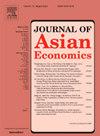The impact of AI adoption on R&D productivity: Evidence from Chinese pharmaceutical manufacturing industry
IF 2.9
3区 经济学
Q1 ECONOMICS
引用次数: 0
Abstract
The decline in R&D productivity is a persistent and widespread phenomenon hindering long-term economic growth. With the boom of artificial intelligence (AI), especially the pervasive application of deep learning, AI is now able to participate in innovation, which is expected to help reverse the decreasing trend of R&D productivity. Focusing on the pharmaceutical manufacturing industry, one of the most active domains in AI-driven innovation, we take Chinese listed firms as an example to investigate the role of AI in drug discovery and the impact of AI adoption on new drug R&D productivity. Our empirical results show that other things being equal, new drug output per billion yuan invested in R&D averagely rises by 0.05–0.06, for each 1-unit increase in our AI-adoption index capturing the firm-level AI usage intensity. One of the mechanisms behind it, which we call “R&D elitism”, positively associates new drug R&D productivity with AI adoption through raising the share of core researchers (by 0.2 % on average in terms of educated staffs or 0.8 % on average in terms of experienced ones under the same condition as mentioned above) in the R&D team. With the power of AI, marginal researchers are getting harder to retain and new drugs are hence getting easier to find.
人工智能应用对研发效率的影响:来自中国医药制造业的证据
研发生产率的下降是阻碍长期经济增长的一个持续而普遍的现象。随着人工智能(AI)的蓬勃发展,特别是深度学习的广泛应用,人工智能现在能够参与创新,这有望帮助扭转研发生产力下降的趋势。医药制造业是人工智能驱动创新最活跃的领域之一,我们以中国上市公司为例,研究人工智能在药物发现中的作用以及采用人工智能对新药研发效率的影响。我们的实证结果表明,在其他条件相同的情况下,每投入10亿元研发资金,我们的人工智能采用指数每增加1个单位,就会平均增加0.05-0.06个单位的新药产量,该指数反映了企业层面的人工智能使用强度。其背后的机制之一,我们称之为“研发精英主义”,通过提高研发团队中核心研究人员的比例(在上述相同条件下,受过教育的员工平均增加0.2 %,经验丰富的员工平均增加0.8 %),将新药研发生产力与人工智能的采用积极联系起来。由于人工智能的力量,边缘研究人员越来越难以留住,因此新药也越来越容易找到。
本文章由计算机程序翻译,如有差异,请以英文原文为准。
求助全文
约1分钟内获得全文
求助全文
来源期刊

Journal of Asian Economics
ECONOMICS-
CiteScore
4.70
自引率
9.40%
发文量
90
期刊介绍:
The Journal of Asian Economics provides a forum for publication of increasingly growing research in Asian economic studies and a unique forum for continental Asian economic studies with focus on (i) special studies in adaptive innovation paradigms in Asian economic regimes, (ii) studies relative to unique dimensions of Asian economic development paradigm, as they are investigated by researchers, (iii) comparative studies of development paradigms in other developing continents, Latin America and Africa, (iv) the emerging new pattern of comparative advantages between Asian countries and the United States and North America.
 求助内容:
求助内容: 应助结果提醒方式:
应助结果提醒方式:


